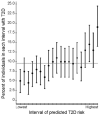A genome-wide association study of type 2 diabetes in Finns detects multiple susceptibility variants
- PMID: 17463248
- PMCID: PMC3214617
- DOI: 10.1126/science.1142382
A genome-wide association study of type 2 diabetes in Finns detects multiple susceptibility variants
Abstract
Identifying the genetic variants that increase the risk of type 2 diabetes (T2D) in humans has been a formidable challenge. Adopting a genome-wide association strategy, we genotyped 1161 Finnish T2D cases and 1174 Finnish normal glucose-tolerant (NGT) controls with >315,000 single-nucleotide polymorphisms (SNPs) and imputed genotypes for an additional >2 million autosomal SNPs. We carried out association analysis with these SNPs to identify genetic variants that predispose to T2D, compared our T2D association results with the results of two similar studies, and genotyped 80 SNPs in an additional 1215 Finnish T2D cases and 1258 Finnish NGT controls. We identify T2D-associated variants in an intergenic region of chromosome 11p12, contribute to the identification of T2D-associated variants near the genes IGF2BP2 and CDKAL1 and the region of CDKN2A and CDKN2B, and confirm that variants near TCF7L2, SLC30A8, HHEX, FTO, PPARG, and KCNJ11 are associated with T2D risk. This brings the number of T2D loci now confidently identified to at least 10.
Figures


References
Publication types
MeSH terms
Substances
Grants and funding
- R56 DK062370/DK/NIDDK NIH HHS/United States
- N01 HG065403/HG/NHGRI NIH HHS/United States
- R01 HG002651/HG/NHGRI NIH HHS/United States
- R01 DK072193/DK/NIDDK NIH HHS/United States
- T32 HG000040/HG/NHGRI NIH HHS/United States
- HG002651/HG/NHGRI NIH HHS/United States
- R01 DK062370/DK/NIDDK NIH HHS/United States
- R01 DK029867/DK/NIDDK NIH HHS/United States
- U01 DK062370/DK/NIDDK NIH HHS/United States
- DK062370/DK/NIDDK NIH HHS/United States
- U54 DA021519/DA/NIDA NIH HHS/United States
- Z01 HG000024/ImNIH/Intramural NIH HHS/United States
- U01 HL084729/HL/NHLBI NIH HHS/United States
- DK072193/DK/NIDDK NIH HHS/United States
- HL084729/HL/NHLBI NIH HHS/United States
LinkOut - more resources
Full Text Sources
Other Literature Sources
Medical
Molecular Biology Databases
Research Materials
Miscellaneous

